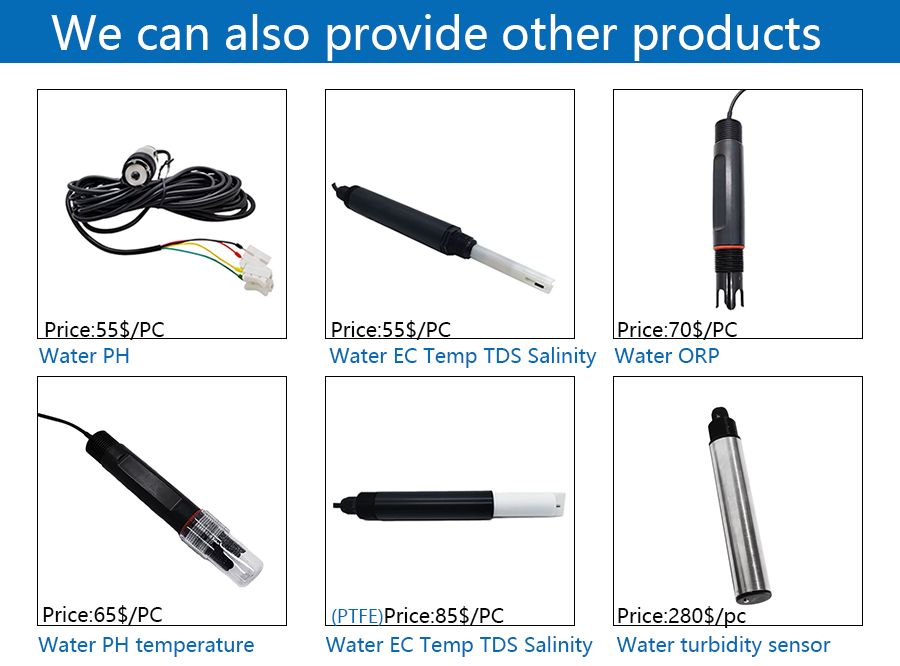Posljednjih godina, potražnja za naprednim rješenjima za praćenje vode značajno je porasla širom svijeta. Ključne zemlje ulažu u tehnologiju kako bi osigurale kvalitet vode za različite primjene, uključujući poljoprivredu, akvakulturu, industrijske procese i vodosnabdijevanje općina. Sljedeći senzori su se pojavili kao ključni alati za kontinuirano praćenje bitnih parametara kvaliteta vode:Senzori pH vrijednosti vode, senzori temperature, senzori EC (električna provodljivost), senzori TDS (ukupno rastvorene čvrste materije), senzori slanosti, senzori ORP (oksidaciono-redukcioni potencijal) i senzori mutnoćeOvaj članak istražuje karakteristike ovih senzora i scenarije primjene, s fokusom na zemlje koje doživljavaju porast potražnje za rješenjima za kvalitet vode.
Senzor pH vrijednosti vode
Karakteristike:
Senzori pH vrijednosti vode mjere kiselost ili alkalnost vode, pružajući ključne informacije za različite primjene. Ovi senzori obično imaju visoku tačnost, stabilnost i hemijsku otpornost. Često su opremljeni digitalnim displejem za lako očitavanje i mogu se integrirati u automatizirane sisteme za praćenje u realnom vremenu.
Scenariji primjene:
- AkvakulturaOdržavanje optimalnog pH nivoa je od vitalnog značaja za zdravlje riba. Mnoge zemlje sa sektorima akvakulture, poput Vijetnama i Tajlanda, koriste pH senzore za praćenje kvaliteta vode u uzgoju ribe.
- PoljoprivredapH senzori se široko koriste u poljoprivredi kako bi se osigurali odgovarajući uslovi za rast usjeva. Zemlje poput Indije i SAD-a implementiraju ove senzore u sisteme za praćenje tla kako bi optimizirale navodnjavanje.
Senzor temperature vode
Karakteristike:
Temperaturni senzori su dizajnirani za precizno mjerenje temperature vode. Često se koriste u kombinaciji s drugim senzorima kako bi pružili sveobuhvatne podatke o kvaliteti vode.
Scenariji primjene:
- Industrijski procesiProizvodni i hemijski pogoni u zemljama poput Njemačke i Kine oslanjaju se na temperaturne senzore za praćenje vode koja se koristi u sistemima za hlađenje.
- Praćenje okolišaZemlje koje se suočavaju s klimatskim izazovima, poput Australije, koriste temperaturne senzore za proučavanje fluktuacija temperature vode u rijekama i jezerima, procjenjujući zdravlje vodenih ekosistema.
Senzori za elektrokondenzaciju (EC), kondeziju mase (TDS) i salinitet vode (PTFE)
Karakteristike:
EC senzori mjere električnu provodljivost vode, što ukazuje na koncentraciju rastvorenih soli. TDS senzori pružaju ukupnu koncentraciju rastvorenih supstanci u vodi, dok senzori saliniteta specifično mjere koncentraciju soli. PTFE (politetrafluoroetilen) senzori su popularni zbog svoje hemijske otpornosti i izdržljivosti u teškim okruženjima.
Scenariji primjene:
- Postrojenja za desalinizacijuZemlje s ograničenim resursima slatke vode, poput Saudijske Arabije i UAE, koriste EC i senzore saliniteta u procesima desalinizacije kako bi pratile kvalitet vode.
- Hidroponika i poljoprivreda bez tlaU Japanu i Holandiji, napredne poljoprivredne prakse koriste ove senzore za optimizaciju nivoa hranjivih tvari u hidroponskim sistemima.
Senzor ORP-a vode
Karakteristike:
ORP senzori mjere oksidacijsko-redukcijski potencijal, što ukazuje na sposobnost vode da oksidira ili redukuje supstance. Ovi senzori su ključni za procjenu nivoa dezinfekcije vode.
Scenariji primjene:
- Tretman vode za pićeU zemljama poput Kanade i SAD-a, ORP senzori su integrirani u komunalne postrojenja za prečišćavanje vode kako bi se pratila efikasnost procesa dezinfekcije.
- Tretman otpadnih vodaPostrojenja u Brazilu i Južnoj Africi koriste ORP senzore kako bi osigurala odgovarajući nivo tretmana, sprečavajući kontaminaciju okoline.
Senzor zamućenosti vode
Karakteristike:
Senzori zamućenosti mjere zamućenost ili mutnoću vode uzrokovanu suspendovanim česticama. Ovi senzori su neophodni za određivanje kvaliteta vode i zahtjeva za tretman.
Scenariji primjene:
- Praćenje kvalitete vodeZemlje koje se suočavaju sa značajnim problemima zagađenja vode, poput Indije i Bangladeša, implementiraju senzore zamućenosti kako bi rutinski provjeravale kvalitet površinskih voda.
- Vodena istraživanjaIstraživačke institucije širom svijeta koriste senzore zamućenosti za proučavanje transporta sedimenta i dinamike kvaliteta vode u rijekama i jezerima.
Trenutna globalna potražnja i trendovi
Rastuća potreba za efikasnim sistemima za praćenje kvaliteta vode podstakla je nedavne inovacije i širenje tržišta senzora za vodu:
- Sjedinjene Američke DržavePovećana ulaganja u inicijative za čistu vodu pojačala su potražnju za sveobuhvatnim senzorima kvaliteta vode, posebno u urbanim područjima koja se suočavaju sa zastarjelom infrastrukturom.
- IndijaFokus vlade na ekološku održivost i poljoprivrednu produktivnost doveo je do usvajanja senzora za vodu i u urbanim i u ruralnim područjima.
- KinaBrza industrijalizacija i urbanizacija dovele su do sve većih propisa o zaštiti okoliša, što je potaknulo industrije da ulažu u tehnologije za praćenje vode kako bi se uskladile s novim standardima.
- Evropska unijaStrožiji ekološki propisi vezani za kvalitet vode rezultirali su povećanom sviješću i usvajanjem tehnologija za praćenje vode u državama članicama.
Zaključak
Raznolikost senzora za vodu dostupnih danas nudi ključna rješenja za praćenje i upravljanje kvalitetom vode u različitim scenarijima. S rastućom globalnom potražnjom u ključnim zemljama, ove tehnologije igraju bitnu ulogu u podsticanju održivih praksi u svim industrijama. Kako zabrinutost zbog kvaliteta vode nastavlja rasti, ulaganje u sofisticirana rješenja za praćenje bit će od vitalnog značaja za zaštitu naših vodnih resursa i osiguravanje sigurnog pristupa vodi za sve.
We can also provide a variety of solutions for 1. Handheld meter for multi-parameter water quality 2. Floating Buoy system for multi-parameter water quality 3. Automatic cleaning brush for multi-parameter water sensor 4. Complete set of servers and software wireless module, supports RS485 GPRS /4g/WIFI/LORA/LORAWAN For more Water quality sensor information, please contact Honde Technology Co., LTD. Email: info@hondetech.com Company website: www.hondetechco.com Tel: +86-15210548582
Vrijeme objave: 22. april 2025.


